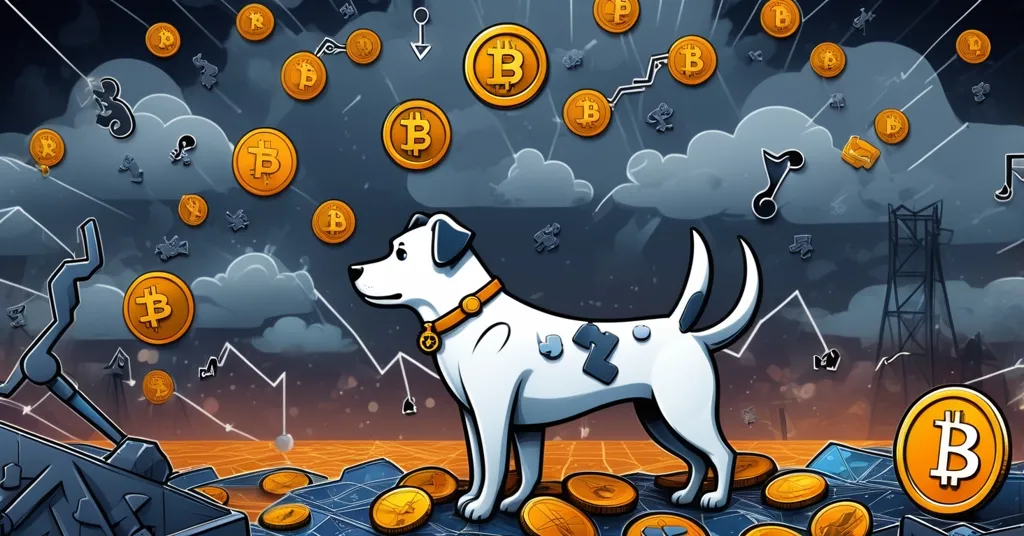Crypto Market Dips 3.5%: XRP, Pi Coin, Shiba Inu, and PEPENODE Under Scrutiny on Nov 3

Crypto Market Downturn: Navigating XRP, Pi Coin, Shiba Inu, and PEPENODE on November 3
The cryptocurrency market took a sharp 3.5% nosedive on November 3, rattled by significant outflows from exchange-traded funds (ETFs), signaling a dip in institutional confidence. Amid this turbulence, we’re zeroing in on four assets—XRP, Pi Coin, Shiba Inu, and a newcomer, PEPENODE—to unpack what’s driving their trajectories, the risks at play, and what they reveal about the broader state of crypto sentiment.
- Market Slump: A 3.5% drop fueled by ETF outflows shakes investor confidence.
- XRP Potential: Regulatory battles loom, but ETF hopes spark optimism.
- Pi Coin & Shiba Inu: Adoption hurdles and fading hype weigh heavy.
- PEPENODE Risk: A presale token with a novel twist, but skepticism is warranted.
Why the 3.5% Market Drop Stings
Before diving into specific projects, let’s set the stage. The recent market dip isn’t just a random hiccup—massive ETF outflows suggest institutional players are either cashing out or reevaluating their exposure to crypto. For context, ETFs are investment vehicles that track asset prices, allowing traditional investors to dip into crypto without directly holding it, much like betting on a stock without owning the company. When money flows out of these funds, it often triggers a ripple effect, spooking retail investors and dragging prices down. Add to that broader economic pressures—rising interest rates, geopolitical uncertainty—and you’ve got a recipe for volatility. Bitcoin, the bedrock of the space, hasn’t been immune, though its relative stability compared to altcoins reinforces why many still see it as the ultimate store of value. This downturn frames the struggles and opportunities for the assets we’re examining today.
XRP: ETF Dreams vs. Regulatory Nightmares
XRP, tied to Ripple’s vision for fast, cheap cross-border payments, sits at $2.40 after a brutal beating—down 5% in the last 24 hours, 8% over the past week, and 20% in the last month. Yet, with a staggering 375% gain year-over-year, it’s clear why many still hold hope. The buzz centers on potential ETF launches, which could open the door to mainstream investment by letting traditional markets bet on XRP’s price without owning the token. Such a move could drive massive demand, with some market watchers suggesting a significant rally if approvals come through.
But let’s cut through the hype. Ripple’s ongoing legal saga with the U.S. Securities and Exchange Commission (SEC), dating back to 2020 over whether XRP is an unregistered security, remains a dark cloud. A favorable ruling could be a game-changer, cementing XRP’s legitimacy and boosting its use case against competitors like Stellar or even traditional systems like SWIFT. However, a negative outcome—or even prolonged uncertainty—could stifle any ETF-driven momentum. On the technical side, XRP’s price charts show what traders call a “bullish pennant pattern,” a formation suggesting a potential breakout after a period of consolidation following a sharp rise. It’s also in “oversold territory,” meaning many believe it’s undervalued based on metrics like the Relative Strength Index (RSI), a tool gauging whether an asset’s price has dropped too far, too fast. Still, external factors like regulatory rulings often trump technical signals in this space. We’re rooting for XRP to disrupt global finance, but banking on ETF approvals without a clear legal win is playing with fire.
Pi Coin: Mobile Mining’s Promise and Pitfalls
Pi Coin (PI), part of the Pi Network’s mission to democratize crypto through mobile mining, is priced at $0.2397, down 3% in a day and 11% in a week, though it’s up 15% over the past two weeks. Recent updates on its mainnet migration—a crucial shift from a test environment to a fully operational blockchain—show progress, with 2.69 million users migrating their tokens and 3.36 million completing Know Your Customer (KYC) verification, a process ensuring user identity for regulatory compliance. For newcomers, mobile mining lets users “mine” tokens via smartphone apps without energy-intensive hardware, a novel idea to lower entry barriers.
Yet, Pi Coin remains a puzzle wrapped in skepticism. It’s not listed on major exchanges like Binance, Coinbase, or Kraken, which severely limits its visibility, liquidity, and credibility. Without that stamp of approval, even promising migration stats feel like small victories in a much larger battle for adoption. Compare this to other mobile-first projects like Electroneum, which struggled with similar challenges despite early hype. Scalability, security, and practical use cases post-mainnet remain unproven for Pi Coin. While the project embodies the spirit of decentralization and accessibility we champion, its slow grind raises a blunt question: is this a revolutionary sleeper hit or just another experiment doomed to obscurity? We lean toward caution—progress is nice, but real-world adoption is the only currency that matters.
Shiba Inu: Meme Coin Fatigue or Hidden Value?
Shiba Inu (SHIB), the once-viral meme coin with a dog-themed origin, is languishing at $0.000009564, down 5% in 24 hours, 8.5% in a week, 23% in a month, and a grim 44% over the past year. Its 24-hour trading volume of $145 million pales next to rival Dogecoin’s $1.8 billion, showing how far it’s fallen in the meme coin pecking order. Technical indicators like RSI and Moving Average Convergence Divergence (MACD)—tools used to spot overbought/oversold conditions and momentum shifts—hint at a possible bounce, suggesting the price might have dropped too far. But let’s not kid ourselves: the fundamentals are shaky. For the latest insights on market trends for SHIB and others, check out this detailed analysis on crypto price movements for November 3.
Shibarium, SHIB’s layer-2 network launched to boost scalability and utility by processing transactions off the main Ethereum chain, hasn’t sparked the expected excitement. Adoption stats are underwhelming, with transaction volumes and developer activity failing to compete with other meme coin ecosystems. Meanwhile, newer tokens like Pepe are stealing the spotlight with fresher gimmicks. Unlike Dogecoin, which occasionally gets a boost from high-profile endorsements, SHIB lacks a clear catalyst—no ETFs on the horizon, no major partnerships grabbing headlines. For a token born on community hype, the silence is deafening. Could SHIB’s loyal pack bark loud enough for a comeback? Possibly, but without a significant spark, betting on nostalgia feels like chasing a ghost. Meme coins fill a cultural niche in crypto, but relevance fades fast.
PEPENODE: Presale Hype or Another Scam Waiting to Happen?
Enter PEPENODE, a new ERC-20 token—meaning it’s built on the Ethereum blockchain for compatibility with various wallets and platforms—currently in presale at $0.0011317. Having raised over $2 million, it’s tapping into the enduring allure of early-stage crypto investments. Its hook is a “mine-to-earn” model, where users earn rewards through virtual mining rigs and staking mechanisms, gamifying the process without the need for costly hardware. Rewards in other tokens like Pepe add a quirky twist, aiming to drive demand as it gears up for public listing.
Let’s be brutally clear: presales are a notorious minefield. For every success story, there are dozens of BitConnects and OneCoins—projects that promised the moon, fleeced investors, and vanished. PEPENODE’s concept is intriguing, but there’s no track record to judge its sustainability. What’s the tokenomics breakdown? How inflationary are the rewards? Is there transparency on the team and roadmap? Without answers, this smells like hype over substance. Historically, gamified models often collapse under their own weight if user growth stalls or rewards devalue the token. We’re all for innovation and pushing blockchain boundaries through effective accelerationism, but unproven projects like this deserve a hard pass until they show real results. Invest only what you can afford to burn—and even then, think twice.
Bitcoin’s Shadow: Why Altcoins Matter (and Don’t)
Stepping back, it’s worth comparing these assets to Bitcoin, the gold standard of crypto. BTC’s relative stability amid this downturn—rooted in its battle-tested network, unmatched security, and ethos of decentralization—underscores why many of us lean toward Bitcoin maximalism. XRP’s payment focus, Pi Coin’s accessibility push, and SHIB’s community vibe fill niches Bitcoin doesn’t aim to serve, and that’s fine. Altcoins and new tokens experiment with ideas that can accelerate adoption, even if most fail. PEPENODE’s gamification, for instance, could inspire future projects, even if it flops. But let’s not lose sight of the bigger picture: Bitcoin’s fundamentals remain unmatched as a hedge against centralized control and a beacon of financial freedom. Altcoins can complement, not replace, that vision.
What This Means for Investors
Navigating this volatile space requires a clear head. The 3.5% market drop is a reminder that sentiment can shift overnight, often driven by factors beyond any single project’s control. XRP might soar if regulatory stars align, but legal setbacks could just as easily derail it. Pi Coin and Shiba Inu face uphill battles for relevance, while PEPENODE is a speculative gamble at best, a scam at worst. Risk management is non-negotiable—diversify, research relentlessly, and never buy into hype without substance. Blockchain’s transformative potential is real, but so are the pitfalls. Focus on the why behind any investment, not empty promises of moonshot gains. No one has a crystal ball, and anyone claiming otherwise is likely selling snake oil.
Key Questions and Takeaways
- What’s behind the 3.5% crypto market drop on November 3?
Significant ETF outflows indicate institutional pullback or profit-taking, triggering broader retail panic and price declines across the board. - Can XRP overcome regulatory hurdles to capitalize on ETF potential?
ETF approvals could unlock huge demand, but Ripple’s SEC battle remains a wildcard—legal clarity is critical for sustained momentum. - Is Pi Coin’s mainnet progress enough to break through adoption barriers?
Migration numbers are a step forward, but without listings on major exchanges like Binance, its reach and credibility stay limited. - Does Shiba Inu have a path to reclaim meme coin relevance?
Technical signals suggest a possible bounce, but weak fundamentals and competition from newer tokens make a lasting recovery doubtful without a major catalyst. - Should investors touch PEPENODE’s presale despite its $2 million raise?
The “mine-to-earn” idea is novel, but presales are high-risk with a history of scams—extreme caution and thorough due diligence are essential.



